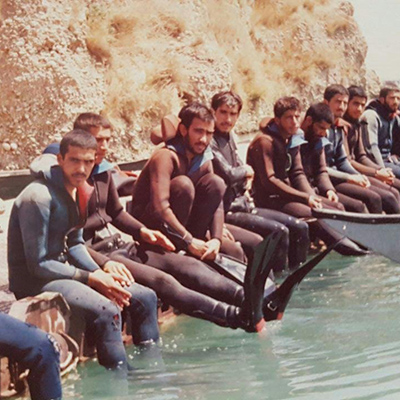Groups, Institutions, Organiza
The 7th Vali-e Asr (as) Division
Fatemeh Khademi
119 دورہ
The 7th Vali-e Asr (as) Division was one of the combat units of the Islamic Revolutionary Guard Corps (IRGC) during the Iran-Iraq War, primarily composed of Basij and IRGC forces from Khuzestan Province. Initially, it was formed in Khuzestan before the onset of the war. Based in the Dezful IRGC, the division’s early forces consisted mainly of fighters from that city.[1] Before the war, the Dezful IRGC was engaged in countering anti-revolutionary groups such as Komala and the Democratic Party in western Iran, a role it continued until the war began.[2]
With Iraq’s nationwide invasion and bombardment of southern Iranian cities, volunteer Basij and local forces from Dezful, Shoush, and Andimeshk, under the supervision of the Dezful IRGC, joined the Iranian Army to confront the enemy. In the western Karkheh region, troops from other provinces were also equipped and organized to halt the enemy’s advance. However, due to the limited number of military forces and insufficient defensive capabilities at the border, the Iraqi army advanced as far as the Naderi Bridge (Karkheh Bridge) and bombarded the Karkheh Barracks. Consequently, the operations unit of the Dezful IRGC was relocated from the Karkheh Barracks to Dezful.[3] Subsequently, Dezful IRGC forces who had been deployed to counter anti-revolutionary groups in the west, were recalled to the southern front. After being stationed in the Dasht-e Abbas, they engaged in irregular warfare until the Dezful Battalion and the 7th Dezful Resistance Brigade were formed.[4]
Consisting of forces from Dezful, Andimeshk, and Shoush, the Dezful Battalion was established before Operation Tariq al-Quds (November 29, 1981) and served as a line-breaking battalion in this operation, marking its first experience in regular military operations. This paved the way for the formation of the Dezful Brigade.[5]
In late 1981, the combat structure of the IRGC was reorganized and the formation of combat brigades became a priority. The Dezful IRGC unit was among the first to be upgraded to a brigade on December 22, 1981. Later on, it was officially named the 7th Dezful Resistance Brigade. Abdolmuhammad Raoufi and Muhammad Hassan Kouseh-chi were appointed as commander and deputy commander of the brigade respectively.[6]
Until Operation Fath al-Mobin, the 7th Vali-e Asr (as) Brigade had been positioned at the Karbala Central Command in the Do-Kouhe Barracks. The brigade’s troops underwent training along the Karkheh River at the combat battalions’ camp, the Martyr Mostafa Khomeini Barracks west of Dezful, and the Andimeshk Plage (behind the Ali-Kaleh Dam in Dezful at an amphibious training barracks).[7]
The 7th Brigade participated in Operation Fath al-Mobin (March 22, 1982) on the Tappeh-Cheshmeh, Karkheh, Saleh Mashtat, and Malehe frontlines where it successfully pushed back the Baathist forces to the international border.[8] In this operation, the brigade captured facilities 4 and 5 in the Abu-Salibi Khat Heights.[9]
Following Operation Fath al-Mobin, the brigade was named Vali-e Asr (as), a title it retained even after its subsequent upgrade to a division.[10]
The second and most significant operation in which the 7th Vali-e Asr (as) Brigade participated was Beit al-Muqaddas (April 30–May 24, 1982), conducted in the west of the Karun River. The objectives included capturing part of the Ahvaz-Khorramshahr Road, securing the international border, and liberating the Shalamcheh-Khorramshahr Road, all of which were successfully achieved. The brigade also took part in Operation Ramazan on July 13, 1982.[11]
Before Operation Preliminary Valfajr (February 1983), the 7th Brigade was upgraded to a division, incorporating additional battalions from cities across Khuzestan and Lorestan provinces.[12] Following its elevation to the 7th Vali-e Asr (as) Division, it participated in operations Preliminary Valfajr (February 6, 1983), Valfajr 1 (April 17, 1983), and Kheibar (February 22, 1984).[13]
The division’s three brigades, composed of forces from Ahvaz, Dezful, Shoushtar, and Andimeshk, took part in Operation Kheibar. These cities provided combat forces for the division. After Operation Kheibar, as the division restructured around battalion-level units, its existing brigades were fully disbanded.[14] The 7th Division consisted of various units, including artillery, operations intelligence, equipment, engineering, medical, communications, human resources, logistics, demolition, armored, air defense, and propaganda.[15]
On September 15, 1986, ahead of Operation Karbala 4, the independent 15th Imam Hassan Mojtaba (as) Amphibious Brigade from Behbahan was dissolved, and its forces joined the 7th Vali-e Asr (as) Division.
The division participated in operations Karbala 4 (December 24, 1986) and Karbala 5 (January 9, 1987) which aimed at capturing and clearing two crescent-shaped positions at the Fish Canal, east of Basra. From the second day of the operation, the division deployed its Qamar Bani Hashem (as) and Malek Ashtar battalions. Later on, it was detached from Quds Command and began operating under the Karbala Command. The first mission assigned by the Karbala Command was to capture the upper-left side of a pentagon-shaped area on which several bridges had been built. The following day, approximately 70 forces of the division’s Fajr Battalion and several from the Malek Ashtar Battalion were injured in the Martyr Safavi Road due to the enemy chemical attacks. After twenty days of intense combat and resistance, the Iranians managed to cross the Fish Canal and the Doueiji and Jassem rivers, establishing positions 6 kilometers east of Basra. Then, they secured captured areas, including the Bubiyan, Shalamcheh, Kot Savari, and Khin outposts, Bovarin, Fayyaz, and Umm al-Tawil islands as well as Bubiyan Lake, and part of the Fish Canal, concluding Operation Karbala 5.[16]
Following Operation Karbala 5, the 7th Vali-e Asr (s) Division participated in operations Nasr 4 (June 21, 1987), Nasr 8 (November 17, 1987), Valfajr 10 (March 14, 1988), and Beit al-Muqaddas 7 (June 13, 1988).[17]
Carrying out heavy attacks on May 25 and June 25, 1988, using extensive chemical weapons in Shalamcheh, Majnoon Islands, and the Jofeir region, the Iraqi army reoccupied areas previously liberated in operations Karbala 5, Kheibar, and Badr. Consequently, a number of troops from the 7th Vali-e Asr Division (as), who had taken defensive positions in Valfajr 10, Nasr 4, Badr, and the Majnoon Islands operational areas were taken captive.[18]
On July 22, 1988, three days after Iran accepted UN Security Council Resolution 598, Iraq advanced into Iranian territory from the Koushk and Shalamcheh, occupying 30 kilometers of the Ahvaz-Khorramshahr Road. The 7th Vali-e Asr (as) Division immediately deployed its combat battalions to the Hamid Barracks intersection to counter the enemy. The battalions advanced towards Koushk, reaching the border without engaging the enemy and establishing a defensive line.[19]
Over the eight-year Iran-Iraq War, the 7th Vali-e Asr (as) Division participated in 14 major operations with 38 battalions.[20]
Following the end of the Iran–Iraq War and the establishment of the five branches of the IRGC, the combat structure of the 7th Vali-e Asr Division (as) was once again reorganized around brigade-level units on November 3, 1988. Therefore, it was placed under the command of the 6th Khuzestan Corps of the IRGC. Its three brigades namely the 1st Armored Hazrat Hojjat (as) (Ahvaz), the 2nd Infantry Imam Hassan Mojtaba (as) (Behbahan), and the 3rd Infantry Hazrat Mahdi (as) (Dezful) were tasked with defending southern Iran’s borders.
In 2008, with the establishment of provincial IRGC units, the division’s 3rd Brigade changed into the independent civilian entity known as the Vali-e Asr (as) Corps of Khuzestan. Also, the 1st and 2nd brigades were placed under the IRGC Ground Forces command.[21]
Commanders of the 7th Vali-e Asr (as) Division since its formation include Abdolmuhammad Raoufi-Nejad (from Operation Fath al-Mobin to Nasr 8), Mahdi Kiani (operations Valfajr 10 and Beit al-Muqaddas 7), Muhammad-Nabi Rudaki, Ahmad Soudagar (martyred due to chemical weapons injuries), Mohsen Kazemeini, Hassan Shahvarpour, Abdolrahman Pourjavadi, and Hassan Hussain-Nejad.[22]
Battalion commanders martyred during the war include Akbar Mansouri (1982, Operation Beit al-Muqaddas, Salman Battalion), Jafar Heidarian (1982, Operation Fath al-Mobin, Abuzar Battalion), and Mostafa Askari (1986, Operation Valfajr 8, Ali ibn Abi Talib (as) Battalion).
23000 forces of the 7th Vali-e Asr (as) Division were martyred, 35000 were wounded and 3500 were taken as prisoners of war. Moreover, 500 unidentified martyrs are listed among the division’s fallen.[23] Currently, the division is a unit of the Vali-e Asr (as) Corps of Khuzestan operating under the IRGC Ground Forces command.
[1] Kuchak, Abdolmuhammad, Atlas-e Lashkar-e 7 Vali Asr (as) dar Doran-e Defa Muqaddas (Atlas of the 7th Vali Asr (as) Division during the Sacred Defense), Tehran, Markaz-e Asnad va Tahqiqat-e Defa Muqaddas-e Sepah, 1st ed., 1398, p. 16.
[2] Ibid.
[3] Ibid.
[4] Ibid., Pp. 16, 20.
[5] Salminejad, Abdolreza, Fatehan-e Site va Radar – Gozaresh-e Amaliyat-e Fatholmobin (The Site and Radar Conquerors – Report on Operation Fath al-Mobin), Vol. 1, Tehran, Niloufaran, 1st ed., 1395, Pp. 13, 14.
[6] Kuchak, Abdolmuhammad, Ibid., p. 16.
[7] Ibid., Pp. 20, 21, 23.
[8] Ibid., p. 48.
[9] Salminejad, Abdolreza, Nabard dar Ramalhaye Jangale Omqar – Gozaresh-e Amaliyat-e Valfajr-e Moqadamati (Battle in the Sands of Omqar Forest – Report on Operation Preliminary Valfajr), Vol. 4, Tehran, Niloufaran, 1397, p. 14.
[10] Kuchak, Abdolmuhammad, Ibid., Pp. 10, 17.
[11] Ibid., Pp. 48, 114, 126.
[12] Ibid., p. 10.
[13] Ibid., Pp. 48, 136, 144, 152.
[14] Ibid., Pp. 20, 21.
[15] Ibid., Pp. 30–42.
[16] Ibid., Pp. 190, 202, 205, 214, 48.
[17] Ibid., p. 48.
[18] Ibid., p. 258.
[19] Ibid., p. 259.
[20] Ibid., p. 10.
[21] Ibid., p. 21.
[22] Ibid., Pp. 27, 273.
[23] Ibid., Pp. 262–266.





